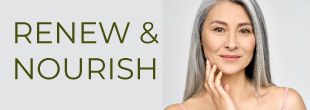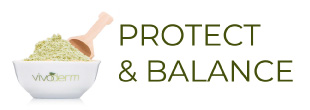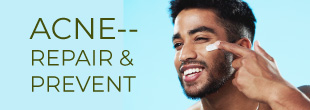Sun Care
Sunburns and skin damage are caused by exposure to too much ultraviolet (UV) light
UV radiation is a wavelength of sunlight in a range too short for the human eye to see. UV light rays that reach the earth are divided into two wavelength bands — ultraviolet A (UVA) and ultraviolet B (UVB). Commercial tanning lamps also produce UV light. Despite appearances, you can still sunburn on hazy or cloudy days. As much as 90% of UV rays pass through clouds. Intense or repeated sun exposure accelerates aging and increases risk of various skin diseases, including actinic keratoses and skin cancer. The sun also contributes to dry, rough skin, deep wrinkles, age spots and fine red veins on the nose and cheeks.
People with fairer skin are more likely to sunburn than are people with dark skin, since those with skin that is darker have more melanin. Although melanin offers certain protection from sunburn, it does not protect against UV-induced damage to the skin. Regardless of skin type, the sun’s energy pierces deeply into skin and can damage the skin’s delicate cellular structure.
You can prevent sunburn and related skin conditions by protecting your skin with clothing and sun block whenever you are outdoors. It is important to note that some common sunscreen ingredients are suspected carcinogens and/or hormone disrupters. Educating yourself on product ingredients and their effects are on your skin is vital.
Zinc oxide is a mineral that provides great UVB/UVA protection, has anti-inflammatory properties, and is considered a natural nontoxic sunscreen. Vivoderm Zinc cream contains Zinc Oxide as well as other beneficial ingredients for sun protection and skin healing.
Sun Protection and Photo Aging
“Photo-aging” is the term used to describe the damage that is done to the skin from prolonged exposure to the sun’s UV radiation The amount of photo aging that develops depends on different factors such as a person’s skin color and their history of long-term or intense sun exposure. Studies have shown that repeated ultraviolet (UV) exposure breaks down collagen and impairs the synthesis of new collagen. The sun also attacks our elastin causing the skin to become loose, wrinkled, and leathery.
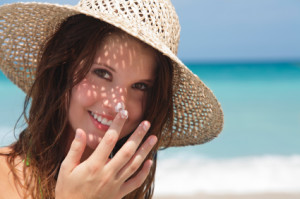
Ultraviolet radiation penetrates the layers of the skin. Both UVA and UVB rays cause damage leading to wrinkles, lower immunity against infection, aging skin disorders, and cancer. However, they appear to damage cells in different ways.
UVB rays are the main cause of sunburns, and primarily affects the outer skin layers. UVB is most intense at midday when sunlight is brightest. Slightly over 70% of the yearly UVB dose is received during the summer. Only 28% is received during the remainder of the year.
UVA rays penetrate more deeply and efficiently. The intensity of UVA rays is less dependent on the time of day and season of the year than UVB rays. For example, you receive only about half of your yearly UVA dose during the summer months, with the balance spread over the rest of the year.
Dermatologists and doctors agree, sun protection products should be worn year round. It is important to apply sunscreen diligently during the summer months as it is most intense at this time. If you live at a high altitude, UV rays are almost twice as harsh. Combined with the reflective snow surface, high altitude sun can damage skin at a surprisingly fast rate and cause just as much damage as sun burns on the beach!
Sunscreen Product Facts
- Use Broad Spectrum sunscreen / sunblock (protects from BOTH UVA and UVB rays)
- SPF is only related to UVB protection and does not provide a reference to the UVA protection in the product.
- All sunscreens will have UVB protection, which is reflected in the SPF.
- If skin sunburns in 10 minutes, a properly applied sunscreen SPF 15 means they will burn in 15-20 minutes
- Natural mineral sunblocks reflect light (and are not absorbed into the skin) whereas chemical sunscreens absorb through the skin and use UV converting the energy into heat at multiple layers
- SPF15 blocks 87.5% of UVB and SPF 50 blocks 98% of UVB.
If you are looking for the best all around protection against UV rays, Zinc Oxide or Titanium is your best choice. Zinc Oxide has a superior ability to protect your skin from UVA radiation. So, it is the natural, organic star of the skin care products available today. Zinc may leave a slight ‘white-cast’ on your skin, but considering the alternative chemical-laden, inflammatory or allergy-inducing options for sun protection today, zinc is an excellent choice for sensitive skin. Currently there are also “micro-fine” version of zinc to eliminate this effect without changing the power of the sunscreen itself.
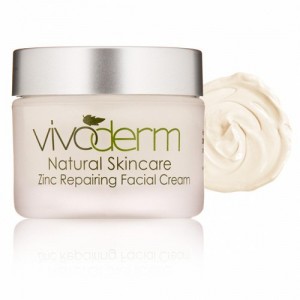
Always look for a sunscreen product that is dual-spectrum, meaning it blocks both UVA and UVB rays. UVA rays are the rays that cause wrinkles and skin aging, while UVB rays produce tans and burns. Applying sunscreen to not only the face but body is important. Sunscreen should be applied daily and even multiple times during the day depending on your outdoor activities. Sun protections no lower than SPF 30 should be applied to the face and body.
Natural products note: Many may also be unaware they can EAT for sun protection! Natural anti-oxidants from fresh berries, green tea, spirulina and many other foods act as natural barriers to the harmful effects of the sun. This is NOT a replacement for sunscreen though!
The Sunscreen Product Debate – Potentially Harmful Ingredients of Sunscreens
You may be wondering, “How effective are sunscreens in protecting the skin against UVA and UVB rays from the sun? How harmful are their ingredients? Do sunscreens damage more than they protect?” Many have reported the very ingredients in sunscreens that offer sun protection, have also been found to have adverse side effects
While the debate between whether sunscreens are safe or not continues, chemical watchdog, the Environmental Working Group reported 84% of sunscreen products are harmful to consumers.
The bottom line is this. It is up to you as the informed consumer to research all skin care and sunscreen products you use, not only for efficacy but for safety as well. You only have one body, do your best to protect it and treat it well. Avoid prolonged exposure to the sun and take necessary precautions and measures to increase your natural sun protection factor and avoid future skin damage.


